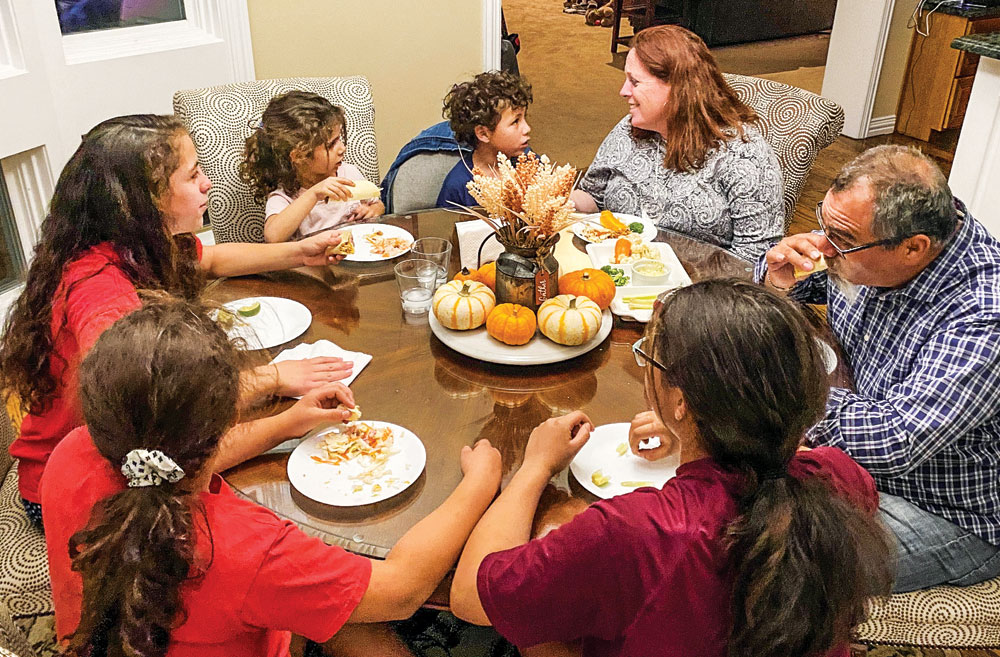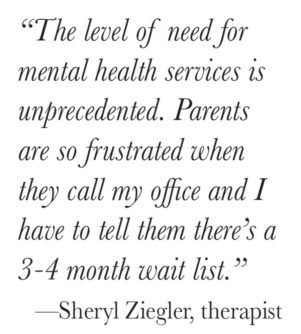
Clare Chavez (upper right) says it’s been important for her family’s mental health to eat meals together, so everyone can talk about their day. Cellphones are never permitted at the table and there are strict limits about when and where cellphones can be used.
Jenna Glover doesn’t mince words. She says the COVID-19 pandemic has caused a full-blown mental health crisis in children and teens, especially with issues of depression and anxiety. “I’m seeing double the rates I saw pre-pandemic. I’ve never seen a jump like that in terms of acute mental health problems in my entire career.” Glover trains and supervises therapists at Children’s Hospital Colorado and is also a clinical psychologist. For years she has led a support group for kids with depression and suicidal thoughts. Before the pandemic, there were about 25 kids on her waitlist. Now that number is 80.
 Lowry therapist Sheryl Ziegler has seen a similar increase. “The level of need for mental health services is unprecedented. Parents are so frustrated when they call my office and I have to tell them there’s a 3-4 month wait list.” Ziegler, who is also the author of “Mommy Burnout,” thinks the root of the mental health crisis was the uncertainty and social isolation caused by the pandemic. “Kids are social learners who need routines. The pandemic disrupted all of that with remote learning which led to social isolation and anxiety.” And although students are now back in the classroom, she says the mental health impacts are likely to last for some time.
Lowry therapist Sheryl Ziegler has seen a similar increase. “The level of need for mental health services is unprecedented. Parents are so frustrated when they call my office and I have to tell them there’s a 3-4 month wait list.” Ziegler, who is also the author of “Mommy Burnout,” thinks the root of the mental health crisis was the uncertainty and social isolation caused by the pandemic. “Kids are social learners who need routines. The pandemic disrupted all of that with remote learning which led to social isolation and anxiety.” And although students are now back in the classroom, she says the mental health impacts are likely to last for some time.
While both Glover and Ziegler say parents shouldn’t be expected to take the place of mental health providers, there are some things parents can do to help kids stabilize. Glover says just getting children and teens back into good routines—where they get enough sleep, nutritious food, and plenty of hydration—can help. “It sounds simple but those really are the foundations for both physical and mental health. It’s a foundation for resiliency,” says Glover. She also says there are ways to build resiliency with structured family activities—and the more that those activities are outside the better. She suggests finding new playgrounds for younger children, regular walks or bike rides, a family movie night, or a campout. “Anything where you can help your kids have positive interactions where they’re feeling joy, excitement, or delight.”

When not in use, all cellphones at the Chavez home must remain plugged into a central charging station on the kitchen counter.
The pandemic also brought new concerns for some parents about how much time kids have been spending on screens, especially on social media accounts such as Instagram, Snapchat, or TikTok. Clare Chavez is the mother of 8 kids, ranging from 22 to 5. “Screens have an addictive quality and so when in-person activities get cancelled, it calls to them to distract them and entertain them.” Chavez says she and her husband have always had strict limits about screen time. They wait until their children are 14 or 15 years old before giving them a phone—and then it’s a flip-phone, not a smart phone. “We try to introduce phone use gradually and show them it’s a tool that can be beneficial or detrimental.” They’ve established digital-free zones: no phones are allowed at the dinner table or in bedrooms, and no phone use after 10pm. “We haven’t gotten much pushback, especially once they see that we’re not trying to punish them, but we’re looking out for what’s best for them,” says Chavez.
Therapist Ziegler agrees that there should be some limits to screen time, but she says she doesn’t see social media as the cause of all evil as she maybe once did. “During the pandemic lockdown, social media was a lifeline for some kids. I think it helped them keep connections with others when they couldn’t see them in person.” She recommends that parents and children sign a digital contract to navigate issues. Common Sense Media offers such contracts for free and Ziegler, a mother of three, says she uses them with her own kids. “They’re so helpful. It provides a nice neutral way to talk about these issues and it prompts you to review the terms of the contract every 30 or 60 days.”
Glover says the recent news reports that Facebook conducted internal research showing that Instagram was unhealthy for teen girls didn’t come as a surprise. “We as researchers have known for a long time that social media has the potential to cause higher rates of depression and anxiety. The hard thing is that people want to say that all social media is bad, and that’s just not true,” says Glover. She argues that social media can be healthy and likens online content to consuming calories. “Not all digital calories are equal. Some are positive and nourish you and some don’t do good things for you. The nourishing content allows kids to express themselves or interact with others. The unhealthy content is passive, where you aren’t interacting with others. Passive is watching Tik Tok for 4 hours, not talking to anyone.”
In addition to signing a digital contract and having digital-free zones in your house, Glover recommends that parents regularly sit next to their child and ask them about what they’re watching, talk about what it means to be a good digital citizen, and discuss privacy and security concerns. She also advises parents to limit kids to just one social media account. “There is research that the larger the number of social media accounts, the greater the increase in depression or anxiety. With multiple accounts, kids have to spend so much time monitoring and curating their digital identity.” She says by limiting kids to one account, it takes the burden off the kids and it’s easier for parents to check what they’re posting. “Some parents want to say all social media is bad. The reality is that it’s here, it’s part of our lives. So how can we use it in a healthy, effective way?”
Photos by Maria Chavez




0 Comments